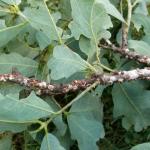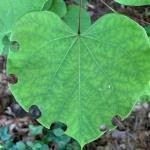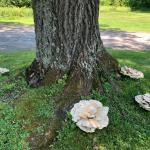UMass Extension's Landscape Message is an educational newsletter intended to inform and guide Massachusetts Green Industry professionals in the management of our collective landscape. Detailed reports from scouts and Extension specialists on growing conditions, pest activity, and cultural practices for the management of woody ornamentals, trees, and turf are regular features. The following issue has been updated to provide timely management information and the latest regional news and environmental data.
The UMass Plant Diagnostic Laboratory has reopened for plant disease, insect pest and invasive plant/weed samples. At this time, we can only accept mail-in samples, walk-in samples cannot be accepted. Please refer to our website for instructions on sample submission and to access the submission form: https://ag.umass.edu/services/plant-diagnostics-laboratory. Mail delivery services and staffing have been altered due to the pandemic, so please allow for some additional time for samples to arrive at the lab and undergo the diagnostic process. We look forward to resuming activities and diagnosing your plant problems!
The UMass Soil & Plant Nutrient Testing Lab is now accepting new orders for routine soil analysis and particle size analysis orders ONLY. Please do not send orders for other types of analyses at this time. Orders should be sent via USPS, UPS, FedEx or other private carrier. The lab office will remain closed to the general public until further notice and hand delivered orders will not be accepted at this time. Processing time will be longer than usual since the lab is operating with reduced staff and staggered shifts. Updates and order forms are available at: https://ag.umass.edu/services/soil-plant-nutrient-testing-laboratory.
Pesticide License Exams - The MA Dept. of Agricultural Resources (MDAR) has begun opening dates to hold exams for new exam applicants. Individuals will be able to begin signing up for new exams beginning 7/9/20. Exams will be held at the Colonial Inn in Gardener under a covered tent and safety precautions will be sent to the examinees ahead of time so that they can be prepared when coming to the exam site. Please be aware that space is still limited. To register, go to https://www.mass.gov/pesticide-examination-and-licensing.
For our COVID-19 Information and Support for Landscapers, Nurseries, Turf Managers, Garden Centers, Arborists, and Greenhouse Operations in Massachusetts, go to
To read individual sections of the message, click on the section headings below to expand the content:
Scouting Information by Region
Environmental Data
The following data was collected on or about July 22, 2020. Total accumulated growing degree days (GDD) represent the heating units above a 50° F baseline temperature collected via our instruments for the 2020 calendar year. This information is intended for use as a guide for monitoring the developmental stages of pests in your location and planning management strategies accordingly.
|
MA Region/Location |
GDD |
Soil Temp |
Precipitation
|
Time/Date of Readings |
||
|
2-Week Gain |
2020 Total |
Sun |
Shade |
|||
|
CAPE |
331.5 |
1186.5 |
76 |
71 |
0.39 |
12:00 PM 7/22 |
|
SOUTHEAST |
347.5 |
1321.5 |
89 |
75 |
0.46 |
3:30 PM 7/22 |
|
NORTH SHORE |
349.5 |
1304.5 |
73 |
69 |
1.65 |
8:30 AM 7/23 |
|
EAST |
369.5 |
1416 |
76 |
70 |
0.76 |
5:00 PM 7/22 |
|
METRO |
354.5 |
1356 |
73 |
68 |
1.01 |
6:00 AM 7/22 |
|
CENTRAL |
361 |
1363 |
67 |
65 |
1.03 |
7:00 AM 7/22 |
|
PIONEER VALLEY |
362 |
1381 |
78 |
70 |
1.21 |
2:00 PM 7/22 |
|
BERKSHIRES |
334 |
1251.5 |
75 |
69 |
1.84 |
8:30 AM 7/22 |
|
AVERAGE |
351 |
1323 |
76 |
70 |
1.04 |
_ |
|
n/a = information not available |
||||||
As of 7/21, this map of MA shows large areas of our state continue to experience "Moderate Drought" (D1) or "Abnormally Dry" (D0) conditions: https://droughtmonitor.unl.edu/CurrentMap/StateDroughtMonitor.aspx?MA
To track water use restrictions/bans by town, regularly check the MassDEP map: https://www.mass.gov/doc/water-use-restrictions-map/download
Phenology
| Indicator Plants - Stages of Flowering (BEGIN, BEGIN/FULL, FULL, FULL/END, END) | ||||||||
|---|---|---|---|---|---|---|---|---|
|
PLANT |
CAPE |
SE |
NS |
EAST |
METRO |
CENT |
PV |
BERK |
|
Clethra alnifolia (summersweet Clethra) |
Begin |
Begin/Full |
Begin |
Begin |
Begin |
Begin |
Begin |
* |
|
Hibiscus syriacus (rose-of-Sharon) |
Begin |
Full |
Full |
Begin/Full |
Begin/Full |
Begin/Full |
Begin |
Begin |
|
Lythrum salicaria (loosestrife) |
Begin/Full |
Full |
Begin |
Begin |
Full |
Full |
Full |
Full |
|
Buddleia davidii (butterfly bush) |
Begin |
Full/End |
Full |
Begin |
Full |
Full |
Full |
Full |
|
Oxydendrum arboreum (sourwood) |
Full/End |
* |
Full |
Full |
End |
Full |
Full |
* |
|
Hydrangea macrophylla (bigleaf Hydrangea) |
Full |
Full/ End |
Full |
Full |
Full/End |
Full |
Full |
Full |
|
Campsis radicans (trumpet vine) |
Full |
Full |
Full/End |
Full |
Full/End |
Full |
Full/End |
Full |
|
Hydrangea paniculata (panicle Hydrangea) |
Full |
End |
Full |
Full/End |
Full/End |
Full/End |
Full |
Full |
|
Tilia cordata (littleleaf linden) |
End |
* |
End |
End |
End |
* |
End |
End |
| * = no activity to report/information not available | ||||||||
Regional Notes
Cape Cod Region (Barnstable)
General Conditions: The average temperature for the period from July 8 – July 22 was 73˚F with a high of 89˚F on July 21 and a low of 53˚F on July 17. Overall, the period has been warm with highs in the 80s and lows around 70˚F except for a brief cool period from July 15 – July 17 when temperatures struggled to reach 70˚F and lows were in the 50s. Humidity and sunlight have been variable. During the period, less than half an inch of precipitation fell, leaving topsoil moisture very short and subsoil moisture short. The lack of precipitation is primarily being seen in landscape ornamentals and turf.
Pests/Problems: Large populations of lecanium scale adults appear to have been attacked by entomopathogenic fungi and infested scales can be seen readily on branches (see image). Even with attack by entomopathogenic fungi, populations still remain high and the scale has entered the crawler stage which can now be found on the leaves of plants (see image). Areas with high populations will soon see the development of sooty mold again. Other insects or insect damage seen during the period includes: lacebugs on azalea, Andromeda, and sycamore; Japanese, Oriental, and Asiatic beetle adults on ornamentals (anecdotally, there seems to be more damage than in recent years, especially from Asiatic beetles); bark beetle damage to eastern red cedar; turpentine beetle damage to pitch pine; pine tip moth damage on pitch pine and mugo pine; Euonymus scale on Euonymus; daylily leaf miner on daylily; columbine leaf miner on columbine; spidermites on catmint and Buddleia, chilli thrips on Hydrangea; earwig damage on Buddleia and H. paniculata, and Hibiscus sawfly on hardy Hibiscus.Disease symptoms or signs observed during the period include brown rot on ornamental cherry, apple scab and cedar apple rust on crabapple, powdery mildew on flowering dogwood, anthracnose on flowering dogwood, Septoria leaf spot on red twig dogwood, anthracnose on red maple, Cercospora leaf spot on bigleaf and oak leaf Hydrangea, Iris leaf spot on bearded Iris, Macrophoma leaf spot on boxwood, Volutella blight on boxwood, tip blight on Leyland cypress, dollar spot on turf, leaf spot on river birch, and powdery mildew on the usual (Monarda, lilac, Phlox, and rose). Other issues seen during the period include girdling roots on red maple and leaf scorch on dogwoods. Purslane, prostrate spurge, and crabgrass are all thriving under the dry soil moisture conditions. Rabbits continue to be a serious issue for those with perennials and annuals. Keep yourself protected from ticks.
Southeast Region (Dighton)
General Conditions: The past two weeks have been a trifecta of heat, humidity and insufficient rain. Unirrigated turf is burnt out and brown. A great flight of Oriental Beetles ended as suddenly as it began with ominous portent for the fall. Happily, Monarch butterflies have arrived. Great golden digger wasps and organ pipe mud dauber wasps can be seen harassing hummingbirds over the most productive flower banks. Hawk moths can be observed there as well. All of the weeds you haven't gotten to are now laden with seed. Oh, the bounty of summer! The following plants are in bloom: Daucus carota (Queen Ann's lace), Monarda didyma, M. fistulosa (beebalm), Phlox paniculata (garden Phlox), Lysimachia clethroides (gooseneck loosestrife), L. punctata (yellow loosestrife), Lythrum salicara (purple loosestrife), Calystegia sepium (hedge bindweed), Hemerocallis spp. (daylily), Lilium spp., L. canadense (Canada or meadow lily, a native of N.A,), L. tigrinum/L. lancifolium (tiger lily), Campanula rapunculoides (creeping bellflower), Asclepias incarnata (swamp milkweed), A. syriaca (common milkweed), Campsis radicans (trumpet vine), Hydrangea quercifolia (oakleaf Hydrangea), H. paniculata (lacecap Hydrangea), Rudbeckia spp. (black-eyed-Susan), Coreopsis spp.(tickseed), Salvia yangii, previously known as Perovskia atriplicifolia (Russian sage), Albizia julibrissin (Persian silktree, mimosa), Hibiscus syriacus (rose of Sharon), Solidago juncea (early goldenrod), Echinacea spp. (coneflower), Hosta spp.(plantain lily), Verbascum thapsus (great, common or yellow mullein), Clethra alnifolia (summer sweet), Eutrochium purpureum (Joe-Pye-weed) and Rhododendron viscosum (swamp white azalea).
Pests/Problems: Brown rot, a fungal disease caused by Monolinia fructicola (which can be devastating to stone crop fruits) was found on peach. Insect feeding damage was noted on Echinacea. Lawns are struggling with drought and heat while crabgrass is advancing rapidly. Yellow nutsedge (Cyperus esculentus) became very obvious as it is in flower where uncut. Broadleaved weeds are also coming on strong.
North Shore (Beverly)
General Conditions: This reporting period was hot and humid except for a few cloudy days with scattered rain showers and cooler temperatures. Temperatures above 90℉ were recorded on four days during this period. A heat wave came through over the weekend with temperatures in low to mid-90s and high humidity. The average daily temperature for this period was 71℉ with the maximum temperature of 96℉ recorded on July 19 and the minimum temperature of 64℉ recorded on July 16. During this reporting period a few fast moving storms passed through and dropped approximately 1.65 inches of rainfall. Woody plants seen in bloom include: mimosa (Albizia julibrissin), oakleaf Hydrangea (Hydrangea quercifolia), smooth leaf Hydrangea (Hydrangea arborescens), summer blooming Spiraea (Spiraea japonica), tree false Spirea (Sorbaria arborea), mountain Camillia (Stewartia ovata), panicle Hydrangea ( Hydrangea paniculata), Chinese chaste tree (Vitex sinensis), golden rain tree (Koelreuteria paniculata), sourwood (Oxydendrum arboreum), butterfly bush (Buddleia davidii) and Daphne sp. Herbaceous plants seen in bloom include: milkweed (Asclepias spp.), falling stars (Crocosmia spp.), shasta daisy (Leucanthemum x superbum), yarrow (Achillea millefolium), garden phlox (Phlox paniculata), Hostas (Hosta spp.), Sedums (Sedum spp.), Stachys (Stachys officinalis), meadow rue (Thalictrum rochebrunianum), Astilbe (Astilbe spp.), summer flowering roses (Rosa spp.), sweet autumn Clematis vine (Clematis paniculata), spiderwort (Tradescantia spp.), Persicaria (Persicaria polymorpha), water lily (Nymphaea odorata) and an assortment of annuals.
Pests/Problems: Powdery mildew was observed on susceptible lilac varieties. Japanese beetles were causing damage on some plants. Cottony scale was noted on silverbell (Halesia carolina) and bark scale was seen on stems of several azaleas. Crabgrass, yellow sedge and other weeds are thriving due to the hot temperatures and recent precipitation. Lawns are still struggling with drought stress. The recent rain showers have helped but more rains are needed for turf to recover. Deer browsing continued to be observed on Hostas and some other plants. Mosquitoes and ticks are very active. Always protect yourself with repellent when out in the woods.
East Region (Boston)
General Conditions: Hot, Hot, Hot. The heat and humidity soared over the last two weeks as we recorded two heat waves since the last report. The first one, from July 11 to 13, saw temperatures in the low 90s before a welcome reprieve as things cooled off to overnight temperatures in the 50s followed by daytime highs in the mid-70s from July 15 to 17. The second heat wave, four days spanning 7/18 to 7/21, saw temperatures hit 98°F, 101°F, 98°F, and 96°F respectively. We reached temperatures over 90 on 9 of the 14 days. High temperatures ranged from 76°F to 101°F, averaging 90°F. Low temperatures ranged from 54°F to 75°F, averaging 66°F. We have gained 369.5 GDDs to bring the total to 1416 GDDs. Plants in bloom include: Aesculus parviflora (bottlebrush buckeye), Albizia julibrissin (Persian silk tree), Asclepias incarnata (swamp milkweed), Echinacea purpurea (purple coneflower), Heuchera spp. (coral bells), Hibiscus syriacus (rose-of-Sharon), Hosta spp. and cultivars (Hosta), Hydrangea macrophylla (bigleaf Hydrangea), H. paniculata (panicle Hydrangea), Koelreuteria paniculata (golden raintree), Lysimachia clethroides (gooseneck loosestrife), Magnolia virginiana (sweetbay Magnolia), Monarda didyma (crimson beebalm), Nipponanthemum nipponicum (Nippon daisy or Montauk daisy), formerlyPerovskia atriplicifolia, now Salvia yangii (Russian sage) and Platycodon grandiflorus (balloon flower).
Pests/Problems: Lack of soil moisture is a concern. Unirrigated turf is going dormant and turning brown while crabgrass has eagerly put out substantial growth over the last week. Premature leaf drop has begun. Powdery mildew is visible on flowering dogwood, beebalm and Phlox. Mosquitoes are out in abundance.
Metro West (Acton)
General Conditions: We are in the full swing of summer. This area experienced its second heat wave of the summer on July 18th, 19th, 20th, and 21st with temperatures recorded at 91°, 96° (the highest for the year), 92°, and 91° respectively. Overall, there have been 15 days this summer with temperatures recorded in the 90s; 8 of those days occurred in July and the other 7 in June. For July, the historical monthly average precipitation is 4.07” and as of the 21st, 1.48” of rain has been recorded for this area. Observed in some stage of bloom this past couple of weeks were the following woody plants: Aesculus parviflora (bottlebrush buckeye), Albizia julibrissin (Persian silk tree), Buddleia sp. (butterfly-bush), Clethra alnifolia (summersweet), Hibiscus syriacus (rose-of-Sharon), Hydrangea macrophylla (bigleaf Hydrangea), H. paniculata (panicle Hydrangea), Potentilla fruticosa (shrubby cinquefoil), Rhus typhina (staghorn sumac), Rosa 'Knockout' (Knockout family of roses), Rosa rugosa (beach rose), Rosa spp. (rose), Spiraea japonica 'Alpina' (Daphne spirea),and Stewartia psuedocamellia (Japanese Stewartia). Woody vines observed in bloom were: Campsis radicans (trumpet vine) and Clematis spp. Contributing even more color and interest to the landscape are some flowering herbaceous plants including: Achillea millefolium (yarrow), Actaea matsumurae 'White Pearl' (Japanese or Kamchatka bugbane), Asclepias syriaca (common milkweed), A. tuberosa (butterfly weed), Astilbe spp. (false spirea), Boltonia asteroides (Bolton’s aster), Campanula persicifolia (peach-leafed bell flower), C. takesimana ‘Elizabeth’ (bell flower), Cichorium intybus (chicory), Coreopsis spp. (tickseed), C. verticillata (threadleaf Coreopsis), Daucus carota (Queen Anne's lace), Echinacea purpurea (coneflower), Eutrochium purpureum (Joe Pye weed), Gaillardia aristata (Indian blanket flower), Hemerocallis fulva (orange daylily), H. 'Stella D'Oro' (daylily), H. spp. (daylily), Heuchera spp.(coral bells), Hosta spp. (plantain lily), Leucanthemum sp. (shasta daisy), Liatris spicata (spike gayfeather, dense blazing star), Lilium spp. (lily), Lychnis coronaria (rose campion), Lysimachia clethroides (gooseneck loosestrife), Monarda didyma (bee-balm), Nepeta spp. (ornamental catmint), Salvia yangii, formerly Perovskia atriplicifolia (Russian sage), Phlox carolina (Carolina phlox), P. paniculata (garden phlox), Platycodon grandiflorus (balloon flower), Rudbeckia fulgida var. sullivantii 'Goldsturm' (black-eyed Susan), Salvia nemerosa (Salvia), Thymus praecox (thyme), Tradescantia sp. (spiderwort) , Veronica spp. (speedwell), Veronicastrum virginicum (Culver’s root) and Yucca filamentosa (Yucca, Adam’s needle and thread).
Pests/Problems: Observed in the landscape these past two weeks were powdery mildew on Cornus florida (dogwood), Monarda spp. (bee-balm), Phlox sp. and Syringa vulgaris (lilac). Invasive, non-native Lythrum salicaria (purple loosestrife) is thriving in the landscape. The lack of any substantial and steady rain continues to be a concern for our trees and shrubs especially compounded with the hot and humid weather and any other stresses such as winter, tent or gypsy moth caterpillars, hemlock woolly adelgid, snow and ice removal applications, or previous year’s droughts. The U.S. Drought Monitor declared a moderate drought for this area. Signs of stress are apparent in the landscape including premature leaf drop and wilt. Setting seed and quite visible is non-native, invasive, allelopathic Ailanthus altissima (tree of heaven, varnish tree) which gives some people a horrible rash worse than poison ivy upon skin contact. Look for it growing along roadsides and in parking lots and medians. [Editor’s note: Learn more about why this tree is detrimental to our native ecosystems: https://extension.psu.edu/controlling-tree-of-heaven-why-it-matters]
Central Region (Boylston)
General Conditions: This reporting period was brutally hot and humid with six days above 90˚F and an additional four days when the high temperature was near 90˚F. While three inches of rain this month has brought some welcome relief to drought-stressed landscapes, most of that rainfall came in the form of thunder showers - briefly intense rain bursts - leading to a lot of runoff and not enough infiltration. Lots of summer blooming plants are going strong, but this seems to be an exceptional year for Hydrangeas. Hydrangea macrophylla, H. quercifolia, H. paniculata, H. arborescens, and H. serrata are all in full bloom and look amazing. Hemerocallis cultivars are still blooming well; Asclepias tuberosa (butterfly weed), Eutrochium (syn. Eupatorium) maculatum (spotted Joe Pye weed), Lobelia cardinalis (cardinal flower), and countless other native perennials are in various stages of flower. Clethra alnifolia (summersweet), a favorite summer flower for many bee species, is just coming into bloom.
Pests/Problems: The biggest problem across the region remains drought. In central Massachusetts, southern towns are abnormally dry according to the US Drought Monitor. The northern part of the region is experiencing moderate drought with no end in sight. Drought stress has led to early foliage drop as well as exhaustion for any gardener with new plants to establish. Dragging hoses around endlessly is hard work. Mosquitoes are terrible, especially after short rain events. Likely fire blight damage was spotted on Spiraea, and early fall webworm on Clethra alnifolia.
Pioneer Valley Region (Easthampton)
General Conditions: The dog days of summer are upon us as July comes to a close in the Pioneer Valley. High temperatures over this reporting period ranged from 79°F to 98°F, with daily highs >90°F recorded seven times. The zenith of this sweltering late July stretch came on Sunday, 7/19 when ambient air temperatures reached 98°F, in what was a searing hot day. Low temperatures have provided little relief, spanning 64°F to 74°F with high humidity. According to the Northeast Regional Climate Center, high temperatures during the first half of the month (7/1–7/15) were 4–6°F above-average throughout much of the valley. July has been hot. There was hope of a soaking rainstorm as the remnants of Tropical Storm Fay circled around western New England on 7/9 and 7/10. Alas, accumulations in the valley were minimal as the Berkshires received the brunt of the rain. A variety of flowering perennials and annuals are providing beautiful summer color right now and many landscapes appear vibrant. While evidence of drought stress and dieback is everywhere, the landscape has fared pretty well this season, despite the below-average precipitation and above-average heat. Crab grass is growing strong right now as are a variety of other landscape weeds. Watering and weeding are commanding most of a gardener’s attention now as we prepare for August, typically our warmest month of the year. The actions of leaf cutter bees (Megachile spp.) were observed on redbud (pictured below) and PJM Rhododendron. These solitary bees cut circular notches along the margins of smooth-leaved landscape plants. The injury is minor and they are considered valuable pollinators.
Pests/Problems: Various trees and shrubs in full sun settings are off-color and wilting from the dry conditions. Premature shedding of older leaves from drought has also been observed. The lack of adequate soil moisture continues to be a concern, especially after this hot and humid stretch, as the heat results in major water loss due to transpiration. Continue to provide supplemental irrigation to young and recently planted trees and shrubs. Check soil moisture to ensure the root zone is being thoroughly wetted. Maple, birch and oak anthracnose are visible on landscape and forest trees. The devastating effects of Dutch elm disease, caused by Ophiostoma novo-ulmi, are on full display right now. Trees killed by DED should be removed as soon as possible to limit the spread of the disease by elm bark beetles to nearby elms. An array of eriophyid mites and aphids are currently causing leaf galls and distortion. While mostly harmless to plants, knowing the identity of these insects can be useful in calming client fears. Invasive scarab beetles continue to cause damage in the landscape, although adult populations are waning in some areas as they retreat to the soil for egg laying. If you are seeing scarab beetle damage but not the beetles themselves, you may be dealing with the Asiatic garden beetle. This copper-colored beetle feeds at night and then burrows into the soil at the base of plants during the day. If afflicted plants have a bowl-shaped mulch/compost ring, you can dislodge the beetles from their hiding place by flooding the soil in the bowl, enabling manual destruction. Or, carefully excavate the soil with your hands and large numbers may be discovered. Oriental beetle populations have been high and these invasive pests are far easier to catch in comparison to Japanese beetles. Deer browsing damage is locally abundant on arborvitae, yew, and elms with low branches, among others. The dry conditions may have pushed deer into sites they may not browse this time of year. Rabbit damage continues and rodent populations also remain high, especially chipmunks and moles. Wood-rotting fungi are appearing in the landscape. Berkeley’s polypore (Bondarzewia berkeleyi) pictured below on a red oak), chicken of the woods (Laetiporus sulphureus and L. cincinnatus) and the northern tooth fungus (Climacodon septentrionalis) have all been observed recently.
Berkshire Region (Great Barrington)
General Conditions: Hazy, hot, and humid best describe the weather of the past two weeks. The weather station at Pittsfield Airport recorded a record high for the date of 93˚F on July 19. Harriman Airport in North Adams recorded 95˚F on the same day. Through the two-week period, day time highs were consistently in the 80s with humid nights dipping to the 60s and 70s for the most part. Rainfall in the form of brief showers varied considerably depending on location. The heaviest rain fell on the night of July 10 into the morning of July 11 when 0.99 inches was measured at this monitoring site in West Stockbridge. Total for the two weeks (7/8 – 7/22) in West Stockbridge was 1.84, while NEWA stations in Pittsfield recorded 1.91, Richmond at 1.85, and North Adams at 0.95. High winds accompanied the storm on the July10-11. Strong gusts were also experienced over the weekend of July 18 and 19. The winds brought down branches, mostly dead ones, and a few trees, but no power outages were noticed. Despite the rain, there remains a precipitation deficit of 5.55 inches for the year, as measured at Pittsfield Airport. Recent rains tended to leave the soil surface moist but that quickly evaporated with persistent breezes and high temperatures. Digging deeper than one inch of moist soil reveals dry soil. Growth of non-irrigated turfgrass has been slow.
Pests/Problems: Japanese beetles seem to be the predominant insect pest in landscapes at this time though Asiatic garden beetle and oriental beetles are also observed frequently. Adult Asiatic garden beetles are typically found during the day only in the soil. They are active above ground during the night feeding mostly on herbaceous perennials and in vegetable gardens. Likewise, oriental beetles also actively feed on herbaceous plants at night. Aphids, two-spotted spider mite, imported willow leaf beetle were among the few other plant pests observed. The current weather conditions have favored rapid development of powdery mildew on many plants, herbaceous and woody species. Leaf spots, including maple anthracnose, were spotted on many deciduous tree species. Some drought effects have been seen, i.e. yellowing or browning of foliage on plants, including conifers, on drought-prone sites.
Regional Scouting Credits
- CAPE COD REGION - Russell Norton, Horticulture and Agriculture Educator with Cape Cod Cooperative Extension, reporting from Barnstable.
- SOUTHEAST REGION - Brian McMahon, Arborist, reporting from the Dighton area.
- NORTH SHORE REGION - Geoffrey Njue, Green Industry Specialist, UMass Extension, reporting from the Long Hill Reservation, Beverly.
- EAST REGION - Kit Ganshaw & Sue Pfeiffer, Horticulturists reporting from the Boston area.
- METRO WEST REGION – Julie Coop, Forester, Massachusetts Department of Conservation & Recreation, reporting from Acton.
- CENTRAL REGION - Mark Richardson, Director of Horticulture reporting from Tower Hill Botanic Garden, Boylston.
- PIONEER VALLEY REGION - Nick Brazee, Plant Pathologist, UMass Extension Plant Diagnostic Lab, temporarily reporting from Easthampton.
- BERKSHIRE REGION - Ron Kujawski, Horticultural Consultant, reporting from Great Barrington.
Woody Ornamentals
Diseases
Recent pests and pathogens of interest seen in the UMass Extension Plant Diagnostic Lab https://ag.umass.edu/services/plant-diagnostics-laboratory:
Needle and shoot tip blight of Fraser fir (Abies fraseri) caused by Sydowia polyspora. Tree is approximately 25-years-old and has been present at the site for nearly 20 years. Resides in a mulched row with other firs and spruces, of varying age and size. The site is described as partially shaded with good soil drainage. Symptoms included blighted shoot tips and browning needles that have been progressively worsening. A recently removed Fraser fir had similar symptoms. Sydowia polyspora has been increasingly linked to needle and shoot blight on a range of conifers, such as fir and hard pine, across northern temperate regions. On infected needles, Sydowia spores resemble those produced by Rhizosphaera and the two fungi are often confused for one another. However, unlike Rhizosphaera, Sydowia is capable of attacking stems and small branches.
Tubakia leaf blotch (Tubakia sp.) and stem cankering (Coryneum sp.) on white oak (Quercus alba). Mature tree with a dbh of 35”, growing in a lawn setting with full sun and sandy soils. Insect activity was also noted and has likely been a predisposing stress for the tree in previous years. Symptoms of canopy dieback first appeared in autumn of 2019 and this season, the tree has stunted leaves/stems along with worsening dieback. Several Coryneum species are known to attack oaks but the pathogen is far less common on landscape samples, in comparison to Botryosphaeria s.l. species. Tubakia infects oak leaves in the spring but has a long latent period before symptoms develop in mid- to late summer. Since the majority of growth is completed for the year, the resulting damage is believed to be minimal. However, as a component of a disease/insect/environmental stress complex, it can be an important disease.
Shoot and needle blight of White fir (Abies concolor) caused by Phyllosticta. The tree is approximately 30-years-old and is growing in a full sun landscape setting. Beginning in June, needles began browning throughout the canopy. The damage was not apparent in previous years. Phyllosticta species infect a range of conifers, especially arborvitae (Thuja) in southern New England, and are known to attack true firs (Abies) in landscape and Christmas tree farm settings. Drought stress is a common predisposing stress that allows the pathogen to establish.
Grey leaf blight, caused by Pestalotiopsis, on Leucothoe axillaris. The shrub was only recently planted at the site in mid-June, into a shaded garden with good soils and compost but no supplemental irrigation due to high soil moisture. Symptoms developed soon after planting and included a marginal leaf blight advancing towards the leaf base. Pestalotiopsis is common on ericaceous shrubs like Rhododendron, azalea, Andromeda and mountain laurel. The fungus is a known endophyte, meaning it can live within host plants without causing symptoms of disease. The shock of transplant and change in site conditions may have facilitated disease development.
Stem and small branch cankering on red maple (Acer rubrum) caused by Cytospora. Stressed and weakened tree, approximately 30-years-old, growing in a full sun, landscape setting. Signs of stress were present in 2019 and appeared as canopy dieback. This year, leaf production was sparse and leaves were undersized and many buds simply did not flush new growth. Cytospora was abundant on the submitted sample but likely established after some predisposing stress weakened the tree. What underlying stresses were present remain unknown.
Diplodia blight, caused by Diplodia sapinea, on deodar cedar (Cedrus deodara). Tree is 10-years-old and has been present at the site for five years. The tree is growing in an arboretum setting with full sun and was watered as needed during the first few years of establishment. Submitted shoots had blackened and wilted needles and Diplodia was readily located from the shoot tips.
Foliar blight and stem cankering caused by the anthracnose pathogen Colletotrichum on spicebush (Lindera benzoin). Numerous, older plants that range in size from 6–12’ tall. Some plants may have been native while others were planted many years ago. Shrubs are growing in a shaded, forest setting that receives management (invasive removal, etc.) adjacent to a private landscape. The plants leafed out in the spring and then shortly after began wilting and losing foliage. Some of the over 100 plants were completely defoliated. The submitted sample had blackened, distorted and collapsed foliage along with blackened stems with obvious cankering symptoms. Colletotrichum was quite abundant from all symptomatic tissues. This pathogen has a very broad host range and can cause a range of foliar symptoms (spots, blotches and blight), shoot blights, fruit rots and stem cankers. While uncommon, it is capable of causing serious damage to landscape plants, as was the case here.
Leaf curling, premature shedding and canopy dieback on Japanese maple (Acer palmatum) caused by Phomopsis. Tree is 10-years-old and has been present at the site for two years. Planted in full sun and provided with drip irrigation. Managing arborist suspected Verticillium wilt, which is very common and destructive on this host. However, the submitted sample failed to produce this vascular wilt pathogen. The opportunistic stem cankering pathogen Phomopsis was abundant on the blighted stems. Transplant shock or winter injury may have predisposed the tree to infection.
Oak leaf blister (Taphrina caerulescens), foliar anthracnose (Colletotrichum) and stem/branch cankering (Botryosphaeria) on a declining red oak (Quercus rubra). The tree is roughly 60-years-old and has been exhibiting canopy dieback symptoms for multiple years. Other oaks on the property have died in the past. This particular tree has been treated to control gypsy moth for several years and defoliation was minimal. Other stresses are likely present and may include root disease, drought stress (soils are somewhat compacted), boring insects and armored scales. Of the three pathogens located, Botryosphaeria is by far the most concerning. This ubiquitous cankering pathogen has been associated with decline and dieback of oaks throughout the northeast. Several species are present in the region and while their virulence varies, they often require prior stress to cause significant injury.
Dieback of groundcover juniper (Juniperus conferta 'Blue Pacific') caused by Phomopsis juniperovora, Lophodermium juniperinum and Pestalotiopsis. Approximately 35-40 junipers were planted along a driveway in June of 2018. Half of these plants died and were replaced in June of 2019. This year, needle browning and dieback appeared again. While some of the diseased plants are along the driveway, others also exhibiting disease symptoms are positioned above a retaining wall and avoid snow and salt-related injuries. The plants receive half-sun and irrigation is provided with overhead sprinklers, which may be facilitating disease development. While Lophodermium and Pestalotiopsis are not considered aggressive pathogens of Juniperus, the opposite is true for Phomopsis.
Report by Nick Brazee, Plant Pathologist, UMass Extension Plant Diagnostic Lab, UMass Amherst.
Insects
Did you miss the live broadcasts of UMass Extension’s Invasive Insect Webinar Series? No problem! View the archived recordings of all seven webinars here: https://ag.umass.edu/landscape/education-events/invasive-insect-webinars
Interesting Insects Reported or Seen Since the Last Landscape Message:

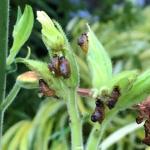
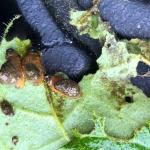 Three-lined Potato Beetle: Lema daturaphila was spotted defoliating ornamental Nicotiana spp. on 7/11/2020 in Plymouth County, MA. Nicotiana as a genus includes not only smoking tobacco, but also ornamental flowering tobacco. This ornamental is planted as an annual with showy flowers available in many colors, with smaller leaves. Other relatives found in the nightshade family (Solanaceae) include petunias, tomatoes, peppers, eggplants, and potatoes. The three-lined potato beetle is a pest of potato (uncommon) and tomato (rare) and some of their relatives. This insect is most commonly found on tomatillo (Physalis ixocarpa). Adults are ¼ inch in length, orange-yellow in color, with three lengthwise black stripes on their elytra (hardened wing covers). Females will lay orange-yellow eggs in groups on the undersides of leaves. Larvae hatch in late June or July and have black heads. Larvae feed in groups, and like some other Chrysomelidae (leaf beetles), they cover themselves with their own excrement. In the Northeast, a second generation is possible in August. Both the larvae and the adults feed on foliage. Injury is minor on tomato and potato, but can be severe on tomatillo. These insects are likely to overwinter in New England in the soil in the pupal stage. In the case of three-lined potato beetle on ornamental flowering tobacco, hand-picking to remove adults and larvae should be acceptable for managing this insect.
Three-lined Potato Beetle: Lema daturaphila was spotted defoliating ornamental Nicotiana spp. on 7/11/2020 in Plymouth County, MA. Nicotiana as a genus includes not only smoking tobacco, but also ornamental flowering tobacco. This ornamental is planted as an annual with showy flowers available in many colors, with smaller leaves. Other relatives found in the nightshade family (Solanaceae) include petunias, tomatoes, peppers, eggplants, and potatoes. The three-lined potato beetle is a pest of potato (uncommon) and tomato (rare) and some of their relatives. This insect is most commonly found on tomatillo (Physalis ixocarpa). Adults are ¼ inch in length, orange-yellow in color, with three lengthwise black stripes on their elytra (hardened wing covers). Females will lay orange-yellow eggs in groups on the undersides of leaves. Larvae hatch in late June or July and have black heads. Larvae feed in groups, and like some other Chrysomelidae (leaf beetles), they cover themselves with their own excrement. In the Northeast, a second generation is possible in August. Both the larvae and the adults feed on foliage. Injury is minor on tomato and potato, but can be severe on tomatillo. These insects are likely to overwinter in New England in the soil in the pupal stage. In the case of three-lined potato beetle on ornamental flowering tobacco, hand-picking to remove adults and larvae should be acceptable for managing this insect.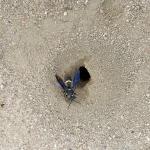
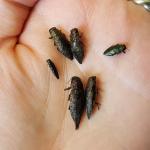 “Smokey Winged Beetle Bandit”: Cerceris fumipennis is a native, ground-nesting wasp that is excellent at finding buprestid beetles, or the jewel beetles, including our own native species as well as the invasive emerald ash borer. The female wasps will collect these jewel beetles and provision their own individual (although aggregated) subterranean nests with paralyzed beetles on which they will lay an egg. Although these wasps are not able to decrease the emerald ash borer population in the state, they can be used as a monitoring tool with a technique known as biosurveillance. These wasps nest in hard-packed, sandy soils in full sunlight, such as those found in baseball diamonds and along dirt roads. These wasps, although large, are incapable of stinging people. They can be distinguished from other ground-nesting wasps that might offer a painful sting by their black body with a single yellow band on the abdomen and yellow spots on the head (3 on the females, 2 on the males) and their blue-black iridescent wings. The openings to their nests are about the thickness of a pencil and often have a buildup of sand in a mound around them, known as a tumulus. Sometimes jewel beetles (including the emerald ash borer) can be found on the ground, scattered between the groups of nests. If you find these wasps nesting in a ballfield or other such area, there is no need to remove them or kill them (no one will get stung). So please, help preserve this wonderful native insect!
“Smokey Winged Beetle Bandit”: Cerceris fumipennis is a native, ground-nesting wasp that is excellent at finding buprestid beetles, or the jewel beetles, including our own native species as well as the invasive emerald ash borer. The female wasps will collect these jewel beetles and provision their own individual (although aggregated) subterranean nests with paralyzed beetles on which they will lay an egg. Although these wasps are not able to decrease the emerald ash borer population in the state, they can be used as a monitoring tool with a technique known as biosurveillance. These wasps nest in hard-packed, sandy soils in full sunlight, such as those found in baseball diamonds and along dirt roads. These wasps, although large, are incapable of stinging people. They can be distinguished from other ground-nesting wasps that might offer a painful sting by their black body with a single yellow band on the abdomen and yellow spots on the head (3 on the females, 2 on the males) and their blue-black iridescent wings. The openings to their nests are about the thickness of a pencil and often have a buildup of sand in a mound around them, known as a tumulus. Sometimes jewel beetles (including the emerald ash borer) can be found on the ground, scattered between the groups of nests. If you find these wasps nesting in a ballfield or other such area, there is no need to remove them or kill them (no one will get stung). So please, help preserve this wonderful native insect!
For more information, visit: http://www.emeraldashborer.info/documents/CFIA-CercerisBook_r06.pdf
Insects and Other Arthropods of Public Health Concern:
- Mosquitoes: On July 3, 2020 the Massachusetts Department of Public Health announced that the eastern equine encephalitis (EEE) virus had been detected in mosquitoes in Massachusetts for the first time this year: https://www.mass.gov/news/state-public-health-officials-announce-seasons-first-eee-positive-mosquito-sample-0 . For more information about the first 2020 EEE detection and ways to protect yourself, visit the link above.
For current information, including searchable risk maps for both EEE and WNV in Massachusetts, visit: https://www.mass.gov/info-details/massachusetts-arbovirus-update
According to the Massachusetts Bureau of Infectious Disease and Laboratory Science and the Department of Public Health, there are at least 51 different species of mosquito found in Massachusetts. Mosquitoes belong to the Order Diptera (true flies) and the Family Culicidae (mosquitoes). As such, they undergo complete metamorphosis, and possess four major life stages: egg, larva, pupa, and adult. Adult mosquitoes are the only stage that flies and many female mosquitoes only live for 2 weeks (although the life cycle and timing will depend upon the species). Only female mosquitoes bite to take a blood meal, and this is so they can make eggs. Mosquitoes need water to lay their eggs in, so they are often found in wet or damp locations and around plants. Different species prefer different habitats. It is possible to be bitten by a mosquito at any time of the day, and again timing depends upon the species. Many are particularly active from just before dusk, through the night, and until dawn. Mosquito bites are not only itchy and annoying, but they can be associated with greater health risks. Certain mosquitoes vector pathogens that cause diseases such as West Nile virus (WNV) and eastern equine encephalitis (EEE).
For more information about mosquitoes in Massachusetts, visit: https://www.mass.gov/service-details/mosquitoes-in-massachusetts
There are ways to protect yourself against mosquitoes, including wearing long-sleeved shirts and long pants, keeping mosquitoes outside by using tight-fitting window and door screens, and using insect repellents as directed. Products containing the active ingredients DEET, permethrin, IR3535, picaridin, and oil of lemon eucalyptus provide protection against mosquitoes.
For more information about mosquito repellents, visit: https://www.mass.gov/service-details/mosquito-repellents https://www.cdc.gov/features/stopmosquitoes .
- Deer Tick/Blacklegged Tick: Check out the archived FREE TickTalk with TickReport webinars available here: https://ag.umass.edu/landscape/education-events/ticktalk-with-tickreport-webinars . Previous webinars including information about deer ticks and associated diseases, ticks and personal protection, and updates from the Laboratory of Medical Zoology are archived at the link above.
The next live webinar will be held on August 12, 2020: Extinction of Deer Ticks in North America - Speaker: Dr. Stephen Rich, Professor of Microbiology, University of Massachusetts Amherst; Director the Laboratory of Medical Zoology
Dr. Stephen Rich will discuss a recent publication in Nature (June 2020) from the Laboratory of Medical Zoology that provides insight to the evolutionary and ecological origin of the primary Lyme disease vectors in North America. To register for the next TickTalk, visit: https://ag.umass.edu/landscape/education-events/ticktalk-with-tickreport-webinars
Ixodes scapularis nymphs (immatures) are active, and may be encountered at this time, through August. Nymphs will have already taken a blood meal, and therefore can be infected with disease causing pathogens. It is important to protect yourself against ticks and be especially vigilant for tiny, difficult to see nymphs. For images of all deer tick life stages, along with an outline of the diseases they carry, visit: http://www.tickencounter.org/tick_identification/deer_tick .
Anyone working in the yard and garden should be aware that there is the potential to encounter deer ticks. The deer tick or blacklegged tick can transmit Lyme disease, human babesiosis, human anaplasmosis, and other diseases. Preventative activities, such as daily tick checks, wearing appropriate clothing, and permethrin treatments for clothing (according to label instructions) can aid in reducing the risk that a tick will become attached to your body. If a tick cannot attach and feed, it will not transmit disease. For more information about personal protective measures, visit: http://www.tickencounter.org/prevention/protect_yourself .
Have you just removed an attached tick from yourself or a loved one with a pair of tweezers? If so, consider sending the tick to the UMass Laboratory of Medical Zoology to be tested for disease causing pathogens. To submit a tick to be tested, visit: https://www.tickreport.com/ and click on the blue “Order a TickReport” button. Results are typically available within 3 business days, or less. By the time you make an appointment with your physician following the tick attachment, you may have the results back from TickReport to bring to your physician to aid in a conversation about risk.
The UMass Laboratory of Medical Zoology does not give medical advice, nor are the results of their tests diagnostic of human disease. Transmission of a pathogen from the tick to you is dependent upon how long the tick had been feeding, and each pathogen has its own transmission time. TickReport is an excellent measure of exposure risk for the tick (or ticks) that you send in to be tested. Feel free to print out and share your TickReport with your healthcare provider.
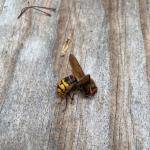
 Wasps/Hornets: Many wasps are predators of other arthropods, including pest insects such as certain caterpillars that feed on trees and shrubs. Adult wasps hunt prey and bring it back to their nest where young are being reared, as food for the immature wasps. A common such example are the paper wasps (Polistes spp.) who rear their young on chewed up insects. They may be seen searching plants for caterpillars and other soft-bodied larvae to feed their young. Paper wasps can sting, and will defend their nests, which are open-celled paper nests that are not covered with a papery “envelope”. These open-celled nests may be seen hanging from eaves or other outdoor building structures. Aerial yellow jackets and hornets create large aerial nests that are covered with a papery shell or “envelope”. Common yellow jacket species include those in the genus Vespula. Dolichovespula maculata is commonly known as the baldfaced hornet, although it is not a true hornet. The European hornet (Vespa crabro) is three times the size of a yellow jacket and may be confused for the Asian giant hornet (Vespa mandarinia). The European hornet is known to Massachusetts, but the Asian giant hornet is not. If you are concerned that you have found or photographed an Asian giant hornet, please report it here: https://massnrc.org/pests/report.aspx . A helpful ID tool, although developed for Texas by the USDA, depicts common look-a-like species that we also have in MA that can be confused for the Asian giant hornet and is found here: https://agrilife.org/lubbock/files/2020/05/Asian_Giant_Hornet_Look-alikes_101_Xanthe_Shirley.pdf .
Wasps/Hornets: Many wasps are predators of other arthropods, including pest insects such as certain caterpillars that feed on trees and shrubs. Adult wasps hunt prey and bring it back to their nest where young are being reared, as food for the immature wasps. A common such example are the paper wasps (Polistes spp.) who rear their young on chewed up insects. They may be seen searching plants for caterpillars and other soft-bodied larvae to feed their young. Paper wasps can sting, and will defend their nests, which are open-celled paper nests that are not covered with a papery “envelope”. These open-celled nests may be seen hanging from eaves or other outdoor building structures. Aerial yellow jackets and hornets create large aerial nests that are covered with a papery shell or “envelope”. Common yellow jacket species include those in the genus Vespula. Dolichovespula maculata is commonly known as the baldfaced hornet, although it is not a true hornet. The European hornet (Vespa crabro) is three times the size of a yellow jacket and may be confused for the Asian giant hornet (Vespa mandarinia). The European hornet is known to Massachusetts, but the Asian giant hornet is not. If you are concerned that you have found or photographed an Asian giant hornet, please report it here: https://massnrc.org/pests/report.aspx . A helpful ID tool, although developed for Texas by the USDA, depicts common look-a-like species that we also have in MA that can be confused for the Asian giant hornet and is found here: https://agrilife.org/lubbock/files/2020/05/Asian_Giant_Hornet_Look-alikes_101_Xanthe_Shirley.pdf .
Paper wasps and aerial yellowjackets overwinter as fertilized females (queens) and a single female produces a new nest annually in the late spring. Nests are abandoned at the end of the season. Annually, queens start new nests, laying eggs, and rearing new wasps to assist in colony/nest development. Some people are allergic to stinging insects, so care should be taken around wasp/hornet nests. Unlike the European honeybee (Apis mellifera), wasps and hornets do not have barbed stingers, and therefore can sting repeatedly when defending their nests. It is best to avoid their nests, and if that cannot be done and assistance is needed to remove them, consult a professional.
Woody ornamental insect and non-insect arthropod pests to consider, a selected few:

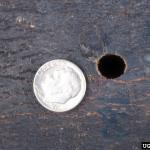
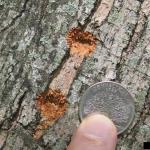 Asian Longhorned Beetle: (Anoplophora glabripennis, ALB) was detected for the first time in South Carolina in 2020. Asian longhorned beetle eradication programs currently exist in Massachusetts, New York, and Ohio. A homeowner is responsible for finding, reporting, and making officials aware of the infestation in South Carolina. Great job!
Asian Longhorned Beetle: (Anoplophora glabripennis, ALB) was detected for the first time in South Carolina in 2020. Asian longhorned beetle eradication programs currently exist in Massachusetts, New York, and Ohio. A homeowner is responsible for finding, reporting, and making officials aware of the infestation in South Carolina. Great job!
The U.S. Department of Agriculture’s (USDA) Animal and Plant Health Inspection Service (APHIS) and the Clemson University’s Department of Plant Industry (DPI) are inspecting trees in Hollywood, South Carolina following the detection and identification of the Asian longhorned beetle (ALB).
On May 29, a homeowner in Hollywood, South Carolina contacted DPI to report they found a dead beetle on their property and suspected it was ALB. A DPI employee collected the insect the same day and conducted a preliminary survey of the trees on the property. Clemson’s Plant and Pest Diagnostic Clinic provided an initial identification of ALB, and on June 4, APHIS’ National Identification Services confirmed the insect. On June 11, APHIS and DPI inspectors confirmed that one tree on the property is infested, and a second infested tree was found on an adjacent property. For more information, visit: https://www.aphis.usda.gov/aphis/newsroom/stakeholder-info/sa_by_date/sa-2020/sa-06/alb-sc .
This is a good reminder for us to remain vigilant, and report any suspicious beetles or damage to trees, especially maples. Asian longhorned beetle infests 12 genera of trees, however maples are preferred hosts.
Look for signs of an ALB infestation which include perfectly round exit holes (about the size of a dime), shallow oval or round scars in the bark where a female has chewed an egg site, or sawdust-like frass (excrement) on the ground nearby host trees or caught in between branches. Be advised that other, native insects may create perfectly round exit holes or sawdust-like frass, which can be confused with signs of ALB activity.
The regulated area for Asian longhorned beetle is 110 miles2 encompassing Worcester, Shrewsbury, Boylston, West Boylston, and parts of Holden and Auburn. If you believe you have seen damage caused by this insect, such as exit holes or egg sites, on susceptible host trees like maple, please call the Asian Longhorned Beetle Eradication Program office in Worcester, MA at 508-852-8090 or toll free at 1-866-702-9938.
To report an Asian longhorned beetle find online or compare it to common insect look-alikes, visit: http://massnrc.org/pests/albreport.aspx or https://www.aphis.usda.gov/pests-diseases/alb/report .
More information can be found in the “Trouble Maker of the Month” section of July’s edition of Hort Notes: https://ag.umass.edu/landscape/newsletters/hort-notes/hort-notes-2020-vol-315
- White Spotted Pine Sawyer (WSPS): Monochamus scutellatus adults can emerge in late May throughout July, depending on local temperatures. The Asian Longhorned Beetle Eradication Program reports that white spotted pine sawyer adult beetle activity is starting to decrease for the season. This is a native insect in Massachusetts and is usually not a pest. Larvae develop in weakened or recently dead conifers, particularly eastern white pine (Pinus strobus). However, the white spotted pine sawyer looks very similar to the invasive Asian Longhorned Beetle, Anoplophora glabripennis, ALB. ALB adults can be present in Massachusetts in July and August. Look for the key difference between WSPS and ALB adults, which is a white spot in the top center of the wing covers (the scutellum) on the back of the beetle. White spotted pine sawyer will have this white spot, whereas Asian longhorned beetle will not. Both insects can have other white spots on the rest of their wing covers; however, the difference in the color of the scutellum is a key characteristic. See the Asian longhorned beetle entry above for more information about that non-native insect.
- Arborvitae Leafminer: In New England and eastern Canada, four species of leafminers are known to infest arborvitae. These include Argyresthia thuiella, A. freyella, A. aureoargentella, and Coleotechnites thujaella. The arborvitae leafminer, A. thuiella, is the most abundant of these and has the greatest known range when compared to the others. (It is also found in the Mid-Atlantic States and as far west as Missouri). Moths of this species appear from mid-June to mid-July and lay their eggs. The damage caused by all of these species is nearly identical. Trees, however, have been reported to lose up to 80% of their foliage due to arborvitae leafminer and still survive. At least 27 species of parasites have been reported as natural enemies of arborvitae leafminers, the most significant of which may be a parasitic wasp (Pentacnemus bucculatricis). Arborvitae leafminer damage causes the tips of shoots and foliage to turn yellow and brown. If infestations are light, prune out infested tips.
- Asiatic Garden Beetle: Maladera castanea adults are active and are typically most abundant in July and August. These rusty-red colored beetles are bullet-shaped and active at night. They are often attracted to porch lights. They feed on a number of ornamental plants, defoliating leaves by giving the edges a ragged appearance and also feeding on blossoms. Butterfly bush, rose, dahlia, aster, and chrysanthemum can be favored hosts.
- Azalea Bark Scale: Eriococcus azaleae was discovered in CT in 1917 and has since been reported in other states. It is found on the bark of twigs and stems and commonly settles in branch crotches. It has been reported on azalea, rhododendron, andromeda, and others. Female scales are approximately 2-3 mm. in length and covered in a white, waxy coating. The females are purple in color and may resemble a mealybug, although they are a soft or felt scale. These females have overwintered and are going to lay eggs which will hatch into crawlers toward the end of June through mid-July. Crawlers will settle into branch crotches, bark crevices, or on the axils of leaves. There is a parasitic wasp that will attack these insects. When high in number, these scales can cause yellowing of the foliage and their sugary excrement can lead to the promotion of sooty mold. Because these are soft scales, they may be targeted with horticultural oils or insecticidal soaps while observing label instructions to prevent phytotoxicity.
- Azalea Sawflies: There are a few species of sawflies that impact azaleas. Johnson and Lyon's Insects that Feed on Trees and Shrubs mentions three of them. Amauronematus azaleae was first reported in New Hampshire in 1895 and is likely found in most of New England. Adults of this species are black with some white markings and wasp-like. Generally green larvae feed mostly on mollis hybrid azaleas. Remember, sawfly caterpillars have at least enough abdominal prolegs to spell “sawfly” (so 6 or more prolegs). Adults are present in May, and females lay their eggs and then larvae hatch and feed through the end of June. There is one generation per year. Nematus lipovskyi has been reared from swamp azalea (Rhododendron viscosum). Adults of that species have been collected in April (in states to the south) and May (in New England) and larval feeding is predominantly in late April and May in Virginia and June in New England. One generation of this species occurs per year, and most mollis hybrid azaleas can be impacted. A third species, Arge clavicornis, is found as an adult in July and lays its eggs in leaf edges in rows. Larvae are present in August and September. Remember, Bacillus thuringiensis Kurstaki does not manage sawflies.
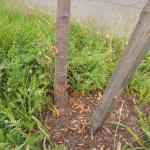
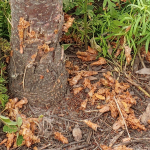
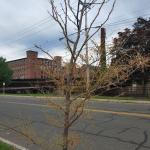
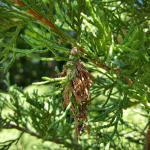 Bagworm: Thyridopteryx ephemeraeformis is a native species of moth whose larvae construct bag-like coverings over themselves with host plant leaves and twigs. This insect overwinters in the egg stage, within the bags of deceased females from last season. Eggs may hatch and young larvae are observed feeding around mid-June, or roughly between 600-900 GDD’s. Remove and destroy overwintering bags before June. In certain areas across MA in 2019, increased populations of bagworms were observed and reported. At this time, bagworm caterpillars are large (hidden within their bags made of chewed leaves and other debris) and capable of completely defoliating young trees. Bagworm caterpillars were reported feeding on honeylocust in Holyoke, MA on 7/22/20. See photos of bagworms at the base of a defoliated tree, as reported by Sarah Greenleaf, MA DCR Urban Forester. More information can be found here: https://ag.umass.edu/landscape/fact-sheets/bagworm
Bagworm: Thyridopteryx ephemeraeformis is a native species of moth whose larvae construct bag-like coverings over themselves with host plant leaves and twigs. This insect overwinters in the egg stage, within the bags of deceased females from last season. Eggs may hatch and young larvae are observed feeding around mid-June, or roughly between 600-900 GDD’s. Remove and destroy overwintering bags before June. In certain areas across MA in 2019, increased populations of bagworms were observed and reported. At this time, bagworm caterpillars are large (hidden within their bags made of chewed leaves and other debris) and capable of completely defoliating young trees. Bagworm caterpillars were reported feeding on honeylocust in Holyoke, MA on 7/22/20. See photos of bagworms at the base of a defoliated tree, as reported by Sarah Greenleaf, MA DCR Urban Forester. More information can be found here: https://ag.umass.edu/landscape/fact-sheets/bagworm- Cottony Taxus Scale: Pulvinaria floccifera, also referred to as the cottony camellia scale, utilizes such hosts as taxus, camellia, holly, hydrangea, Japanese maple, euonymus, magnolia, and jasmine, among others. Females have laid the long, narrow, white and fluted egg sac that makes them much more noticeable. Eggs will hatch over an extended period of 6 weeks and crawlers may be treated between 802-1388 GDD’s. This insect can cause the host to appear off-color. They also produce honeydew which promotes sooty mold growth. Dieback is not common with this insect. Target the underside of the foliage. Horticultural oil, neem oil, and insecticidal soaps may be used to manage these soft scales. Reduced risk options help preserve natural enemies.
- Dogwood Borer: Synanthedon scitula is a species of clearwing moth whose larvae bore not only into dogwood (Cornus), but hosts also include flowering cherry, chestnut, apple, mountain ash, hickory, pecan, willow, birch, bayberry, oak, hazel, myrtle, and others. Kousa dogwood appear to be resistant to this species. Signs include the sloughing of loose bark, brown frass, particularly near bark cracks and wounds, dead branches, and adventitious growth. The timing of adult emergence can be expected when dogwood flower petals are dropping and weigela begins to bloom. Adult moth flights continue from then until September. Emergence in some hosts (ex. apple) appears to be delayed, but this differs depending upon the location in this insect’s range. Eggs are laid singly, or in small groups, on smooth and rough bark. Female moths preferentially lay eggs near wounded bark. After hatch, larvae wander until they find a suitable entrance point into the bark. This includes wounds, scars, or branch crotches. This insect may also be found in twig galls caused by other insects or fungi. Larvae feed on phloem and cambium. Fully grown larvae are white with a light brown head and approx. ½ inch long. Pheromone traps and lures are useful for determining the timing of adult moth emergence and subsequent management.
- Dogwood Sawfly: Macremphytus tarsatus larvae are commonly seen feeding on dogwoods, especially gray dogwood (Cornus racemosa). One generation occurs per year. The larvae of the dogwood sawfly overwinter in decaying wood and occasionally (rarely) compromised structural timber. An overwintering “cell” is created in this soft wood. Pupation occurs in the springtime and adults can take a lengthy time to emerge, roughly from late May through July. 100+ eggs are laid in groups on the underside of leaves. Eggs hatch and the larvae feed gregariously, initially skeletonizing the leaves. As the caterpillars grow in size, they are capable of eating the entire leaf, leaving only midveins behind. Larval appearance varies greatly throughout instars. Early instars are translucent and yellow, but as the caterpillars grow, they develop black spots (over the yellow) and become covered in a white powder-like material. Larvae and their shed skins may resemble bird droppings. Full-grown larvae begin to wander in search of a suitable overwintering location. Rotting wood lying on the ground is preferred for this. Sawfly caterpillars can be collected from plants and dropped into a can of soapy water.
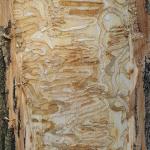
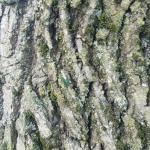
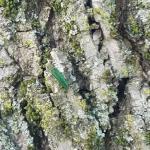 Emerald Ash Borer: (Agrilus planipennis, EAB) As of March 2020, the Massachusetts Department of Conservation and Recreation has confirmed a total of at least 116 communities in Massachusetts that have known populations of emerald ash borer. A map of these locations across the state may be found here: https://ag.umass.edu/fact-sheets/emerald-ash-borer .
Emerald Ash Borer: (Agrilus planipennis, EAB) As of March 2020, the Massachusetts Department of Conservation and Recreation has confirmed a total of at least 116 communities in Massachusetts that have known populations of emerald ash borer. A map of these locations across the state may be found here: https://ag.umass.edu/fact-sheets/emerald-ash-borer .
This wood-boring beetle readily attacks ash (Fraxinus spp.) including white, green, and black ash and has also been found developing in white fringe tree (Chionanthus virginicus) and has been reported in cultivated olive (Olea europaea). Adult insects of this species will not be present at this time of year. Signs of an EAB infested tree may include (at this time) D-shaped exit holes in the bark (from adult emergence in previous years), “blonding” or lighter coloration of the ash bark from woodpecker feeding (chipping away of the bark as they search for larvae beneath), and serpentine galleries visible through splits in the bark, from larval feeding beneath. Positive identification of an EAB-infested tree may not be possible with these signs individually on their own.
For further information about this insect, please visit: https://ag.umass.edu/fact-sheets/emerald-ash-borer . If you believe you have located EAB-infested ash trees, particularly in an area of Massachusetts not identified on the map provided, please report here: http://massnrc.org/pests/pestreports.htm .
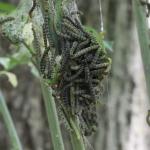 Euonymus Caterpillar: Yponomeuta cagnagella is of European origin and widespread in distribution throughout Europe. It was first reported in North America in Ontario in 1967. The euonymus caterpillars (larvae) feed in groups and envelop the foliage of the host plant in webs as they feed. Hosts include: Euonymus europaeus (tree form), E. kiautschovicus, E. alatus, and E. japonicus. Mature caterpillars are just under an inch in length, creamy yellow-gray in color with black spots and a black head capsule. By late June, these larvae pupate in white, oval-shaped cocoons which are typically oriented together vertically either on host plants or non-hosts in the area. Cocoons can be found in cracks and crevices, or webbed together leaves. The adult moth emerges in late June in most locations. The adult female secretes a gummy substance over her eggs which will harden, making them even more difficult to see. Eggs hatch by mid-August, at which time the tiny larvae prepare to overwinter beneath their eggshell-like covering. These larvae are inactive until the following year, when caterpillars group together to feed on newly emerging leaves, creating a mess of webs as they feed. There is one generation per year. Plants may be partially or entirely defoliated. Management of young, actively feeding caterpillars with Bacillus thuringiensis is possible if deemed necessary, however many species of Euonymus are considered invasive themselves.
Euonymus Caterpillar: Yponomeuta cagnagella is of European origin and widespread in distribution throughout Europe. It was first reported in North America in Ontario in 1967. The euonymus caterpillars (larvae) feed in groups and envelop the foliage of the host plant in webs as they feed. Hosts include: Euonymus europaeus (tree form), E. kiautschovicus, E. alatus, and E. japonicus. Mature caterpillars are just under an inch in length, creamy yellow-gray in color with black spots and a black head capsule. By late June, these larvae pupate in white, oval-shaped cocoons which are typically oriented together vertically either on host plants or non-hosts in the area. Cocoons can be found in cracks and crevices, or webbed together leaves. The adult moth emerges in late June in most locations. The adult female secretes a gummy substance over her eggs which will harden, making them even more difficult to see. Eggs hatch by mid-August, at which time the tiny larvae prepare to overwinter beneath their eggshell-like covering. These larvae are inactive until the following year, when caterpillars group together to feed on newly emerging leaves, creating a mess of webs as they feed. There is one generation per year. Plants may be partially or entirely defoliated. Management of young, actively feeding caterpillars with Bacillus thuringiensis is possible if deemed necessary, however many species of Euonymus are considered invasive themselves.
Want to see euonymus caterpillars in action?! I bet you’ve never seen so many of these caterpillars in one place! Check out Episode 3 of InsectXaminer: https://ag.umass.edu/landscape/education-events/insectxaminer
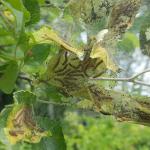
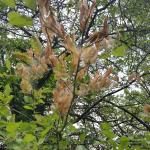 Fall Webworm: Hyphantria cunea is native to North America and Mexico. It is now considered a world-wide pest, as it has spread throughout much of Europe and Asia. (For example, it was introduced accidentally into Hungary from North America in the 1940’s.) Hosts include nearly all shade, fruit, and ornamental trees except conifers. In the USA, at least 88 species of trees are hosts for these insects, while in Europe at least 230 species are impacted. In the past history of this pest, it was once thought that the fall webworm was a two-species complex. It is now thought that H. cunea has two color morphs – one black headed and one red headed. These two color forms differ not only in the coloration of the caterpillars and the adults, but also in their behaviors. Caterpillars may go through at least 11 molts, each stage occurring within a silken web they produce over the host. When alarmed, all caterpillars in the group will move in unison in jerking motions that may be a mechanism for self-defense. Depending upon the location and climate, 1-4 generations of fall webworm can occur per year. Fall webworm adult moths lay eggs on the underside of the leaves of host plants in the spring. These eggs hatch in late June or early July depending on climate. Fall webworm caterpillars were observed feeding on foliage coated in webbing on 7/8/2020 and 7/21/2020 in Chesterfield, MA. Branches fed upon by this insect have web-coated leaves that have now turned brown. Young larvae feed together in groups on the undersides of leaves, first skeletonizing the leaf and then enveloping other leaves and eventually entire branches within their webs. Webs are typically found on the terminal ends of branches. All caterpillar activity occurs within this tent, which becomes filled with leaf fragments, cast skins, and frass. Fully grown larvae then wander from the webs and pupate in protected areas such as the leaf litter where they will remain for the winter. Adult fall webworm moths emerge the following spring/early summer to start the cycle over again. 50+ species of parasites and 36+ species of predators are known to attack fall webworm in North America. Fall webworms typically do not cause extensive damage to their hosts. Nests may be an aesthetic issue for some. If in reach, small fall webworm webs may be pruned out of trees and shrubs and destroyed. Do not set fire to H. cunea webs when they are still attached to the host plant.
Fall Webworm: Hyphantria cunea is native to North America and Mexico. It is now considered a world-wide pest, as it has spread throughout much of Europe and Asia. (For example, it was introduced accidentally into Hungary from North America in the 1940’s.) Hosts include nearly all shade, fruit, and ornamental trees except conifers. In the USA, at least 88 species of trees are hosts for these insects, while in Europe at least 230 species are impacted. In the past history of this pest, it was once thought that the fall webworm was a two-species complex. It is now thought that H. cunea has two color morphs – one black headed and one red headed. These two color forms differ not only in the coloration of the caterpillars and the adults, but also in their behaviors. Caterpillars may go through at least 11 molts, each stage occurring within a silken web they produce over the host. When alarmed, all caterpillars in the group will move in unison in jerking motions that may be a mechanism for self-defense. Depending upon the location and climate, 1-4 generations of fall webworm can occur per year. Fall webworm adult moths lay eggs on the underside of the leaves of host plants in the spring. These eggs hatch in late June or early July depending on climate. Fall webworm caterpillars were observed feeding on foliage coated in webbing on 7/8/2020 and 7/21/2020 in Chesterfield, MA. Branches fed upon by this insect have web-coated leaves that have now turned brown. Young larvae feed together in groups on the undersides of leaves, first skeletonizing the leaf and then enveloping other leaves and eventually entire branches within their webs. Webs are typically found on the terminal ends of branches. All caterpillar activity occurs within this tent, which becomes filled with leaf fragments, cast skins, and frass. Fully grown larvae then wander from the webs and pupate in protected areas such as the leaf litter where they will remain for the winter. Adult fall webworm moths emerge the following spring/early summer to start the cycle over again. 50+ species of parasites and 36+ species of predators are known to attack fall webworm in North America. Fall webworms typically do not cause extensive damage to their hosts. Nests may be an aesthetic issue for some. If in reach, small fall webworm webs may be pruned out of trees and shrubs and destroyed. Do not set fire to H. cunea webs when they are still attached to the host plant.
Hemlock Looper: Two species of geometrid moths in the genus Lambdina are native insects capable of defoliating eastern hemlock, balsam fir, and white spruce. Adult moths lay their eggs on the trunk and limbs of hosts in September and October, and eggs will hatch by late May or early June. (L. fiscellaria caterpillars may be active between 448-707 GDD’s.) Monitor susceptible hosts for small, inch-worm like caterpillars. Where populations are low, no management is necessary. Hemlock loopers have several effective natural enemies.
- Hibiscus Sawfly: The larvae of the hibiscus (mallow) sawfly, likely Atomacera decepta, may be observed feeding on hibiscus hosts at this time. Sawfly larvae develop into wasp-like adults (Order: Hymenoptera) and therefore these “caterpillars” will not be managed by Bacillus thuringiensis var. kurstaki which is specific to the Lepidoptera (caterpillars that develop into moths or butterflies as adults). Reduced risk active ingredients such as spinosad are labelled for use against sawfly larvae. However, given that hibiscus are very attractive to pollinators, non-chemical management options such as hand picking and disposing of larvae, when possible, are best. Spinosad is toxic to pollinators until it dries. For more information about the risks of insecticide active ingredients to pollinators, visit: https://ag.umass.edu/landscape/fact-sheets/tree-shrub-insecticide-active-ingredients-risks-to-pollinators-other-non
The hibiscus (mallow) sawfly adult female uses her ovipositor to cut slits into leaf surfaces to deposit her eggs. Larvae emerge from these eggs and begin by first feeding on leaf undersides when small, and then move to feed on leaf surfaces as they grow in size. Only large leaf veins may be left behind if the population is large enough. Larvae have been observed moving to the base of the plant to pupate. Adults emerge and in some locations in the US, multiple generations have been recorded per year. This insect is known in the mid-Atlantic and Midwest states, but was reported feeding on Hibiscus spp. in Connecticut in 2004 and 2005 and has previously been reported in Massachusetts. The timing of the life cycle of this insect, as well as how many generations occur per year in Massachusetts, however, is not fully understood. Some research has shown that Hibiscus acetosella, H. aculeatus, and H. grandiflora seem to either exhibit some resistance to or tolerance of hibiscus sawfly feeding. In one study, all three had few if any eggs or larvae and were given the lowest damage rating among the species evaluated. This insect also does not feed on Rose of Sharon or H. rosasinensis. It has, however, been reported to “voraciously” feed on H. moscheutos, H. palustris, H. militaris, and H. lasiocarpus.

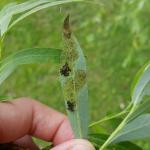 Imported Willow Leaf Beetle: Plagiodera versicolora adult beetles overwinter near susceptible hosts. Adult beetles will chew holes and notches in the leaves of willow once they become available. Females lay yellow eggs in clusters on the undersides of leaves. Larvae are slug-like and bluish-green in color. They will feed in clusters and skeletonize the leaves. Most plants can tolerate the feeding from this insect, and foliage will appear brown. Repeated yearly feeding can be an issue, in which case management of the young larvae may be necessary. Take care with treatment in areas near water. Imported willow leaf beetle may have 2 generations per year in New England (4 generations per year are possible in the warmer locations of its introduced range).
Imported Willow Leaf Beetle: Plagiodera versicolora adult beetles overwinter near susceptible hosts. Adult beetles will chew holes and notches in the leaves of willow once they become available. Females lay yellow eggs in clusters on the undersides of leaves. Larvae are slug-like and bluish-green in color. They will feed in clusters and skeletonize the leaves. Most plants can tolerate the feeding from this insect, and foliage will appear brown. Repeated yearly feeding can be an issue, in which case management of the young larvae may be necessary. Take care with treatment in areas near water. Imported willow leaf beetle may have 2 generations per year in New England (4 generations per year are possible in the warmer locations of its introduced range).
Want to see the imported willow leaf beetle in action? Check out the NEW short (2 min 53 sec) InsectXaminer video now available here: https://ag.umass.edu/landscape/education-events/insectxaminer
- Lacebugs: Stephanitis spp. lacebugs such as S. pyriodes can cause severe injury to azalea foliage. S. rhododendri can be common on rhododendron and mountain laurel. S. takeyai has been found developing on Japanese andromeda, leucothoe, styrax, and willow. Stephanitis spp. lace bug activity should be monitored through September. Before populations become too large, treat with a summer rate horticultural oil spray as needed. Be sure to target the undersides of the foliage in order to get proper coverage of the insects. Certain azalea and andromeda cultivars may be less preferred by lace bugs.
- Lecanium Scales (Oak): Parthenolecanium quercifex overwinters as a second instar nymph on oak twigs. Females will begin feeding and mature in the spring, from mid-April to early May and eggs may be laid between late May and into June. Eggs hatch in June or early July and crawlers migrate to host plant leaves where they spend the summer and migrate as second instars back to host plant twigs in the fall.
- Lilac Borer: Podosesia syringae is a clearwing moth pest of lilac, privet, fringetree, and ash. (It is also known as the ash borer, not to be confused with the emerald ash borer.) Adults mimic paper wasps. Larvae are wood-boring, and signs and symptoms include branch dieback, holes, and occasionally, sawdust-like frass accumulated on bark. Larvae bore into stems, trunks, and branches, chewing an irregularly shaped entrance hole. Peak adult moth flights may occur in the northern portion of this insect’s range in June and is usually over by August 1st. Pheromone traps can be used to time adult emergence. Adult females lay flattened, oval, and tan eggs that are deposited singly or in clusters on bark crevices, ridges, and sometimes smooth bark; but usually laid in or near wounds in the bark. On average, 395 eggs are laid by each female. After hatch, larvae chew into the bark and feed laterally and then vertically in phloem tissue. Larvae overwinter in tunnels in the final instar and resume feeding in the spring. Adults emerge through a round exit hole (4-5 mm. in diameter). This insectmay be targeted between 200-299 GDD’s, base 50°F.
- Magnolia and Tuliptree Scales: The soft scale insects known as the magnolia scale (Neolecanium cornuparvum) and the tuliptree scale (Toumeyella liriodendri) can be difficult to differentiate in the field, depending upon the host they are found on. (On Magnolia, it is very difficult to distinguish between the two species of soft scale.) As two native scale insects in North America, the magnolia and tuliptree scales are hosts themselves for natural enemies that can impact their populations. Solitary parasitoid larvae have been collected from Magnolia scales and have been identified as a syrphid fly species, Ocyptamus costatus. The natural enemies of the tuliptree scale have been studied to a greater degree and include certain lady beetle species [Hyperaspis signata, Adalia (formerly Hyperaspis) bipunctata, and Chilocorus stigma] which feed on nymphal scales, a number of parasitic wasps, and even an insect feeding moth caterpillar (Laetilia coccidivora). This particular moth species, also referred to as a type of snout moth, will consume the tuliptree scale underneath the protection of a silken web it spins over them! (The specific epithet coccidivora can be translated as “ones that eat soft scales” or Coccidae.) Unfortunately, in a landscape setting, it often seems that although these natural enemies may be common within the scale populations, they are seldom able to reduce the scale insect numbers below damaging levels. That being said, our management options should still seek to preserve these natural enemies.
The magnolia scale is distributed throughout the eastern United States. The tuliptree scale is found east of the Mississippi River from Michigan to Alabama and from New York and Connecticut to Florida. It is also reported to be found in ornamental tuliptrees and magnolias in California and could be found wherever these trees are grown. Magnolia scale host plants include: Magnolia stellata (star Magnolia), M. acuminata (cucumber Magnolia), M. lilliflora ‘Nigra’ (lily Magnolia; formerly M. quinquepeta), and M. soulangeana (Chinese Magnolia). Other species may be hosts for this scale, but attacked to a lesser degree. M. grandiflora (southern Magnolia) may be such an example. Tuliptree scale host plants include: Liriodendron tulipifera (tuliptree or yellow poplar), Magnolia stellata (star Magnolia), and M. soulangeana (Chinese Magnolia). This insect has also been recorded on M. grandiflora (southern Magnolia) and Tilia spp. (linden). The tuliptree scale has also, to a lesser extent, been reported on other ornamental trees and shrubs.
Mature individuals settle on a location on branches and twigs, then insert piercing-sucking mouthparts to feed. The insects feed on plant fluids and excrete large amounts of a sugary substance known as honeydew. Sooty mold, often black in color, will then grow on the honeydew that has coated branches and leaves. Repeated, heavy infestations can result in branch dieback and at times, death of the plant. Honeydew may also be very attractive to ants, wasps, and hornets. The life cycle of both of these species is similar and may have similar timing during the year, however subtle differences exist. The life cycle of the magnolia scale is as follows: This scale overwinters as a young nymph (immature stage) which is elliptical in shape, mostly a dark-slate gray, except for a median ridge that is red/brown in color. These overwintering nymphs may be found on the undersides of 1st and 2nd year old twigs. The first molt (shedding of the exoskeleton to allow growth) can occur by late April or May in parts of this insect’s range and the second molt will occur in early June. At that time, the immature scales have turned a deep purple color. Stems of the host plant may appear purple in color and thickened – but this is a coating of nymphal Magnolia scales, not the stem itself. Eventually, these immature scales secrete a white layer of wax over their bodies, looking as if they have been rolled in powdered sugar. By August, the adult female scale is fully developed, elliptical and convex in shape and ranging from a pinkish-orange to a dark brown color. Adult females may also be covered in a white, waxy coating. By that time, the females produce nymphs (living young; eggs are not “laid”) that wander the host before settling on the newest twigs to overwinter. In the Northeastern United States, this scale insect has a single generation per year.
The lifecycle of the tuliptree scale is as follows: The mature female tuliptree scale is hemispherical in shape. The color of the mature female varies in this species as well - a grayish-green to pink-orange insect mottled with black. Adult males emerge sometime in June and mate with the females. Like the Magnolia scale, eggs develop within the body of the female tuliptree scale, leading to the “live birth” of immatures (crawlers) in late August and September. In the Northeast, one generation of tuliptree scales occurs per year. (However, in the southern-most portions of its range, this insect has been found in all stages of development during the winter, suggesting multiple generations per year.) A single female tuliptree scale may produce 3,000+ crawlers in one season. These crawlers are tiny (approximately the size of the head of a pin) and settle on host plant twigs in September. Past studies have shown that in addition to moving on their own with fully functional legs, the crawlers can be blown to new hosts on the wind, up to 100 feet away. (Being wind-blown to a new host, however, is a haphazard method of travel through which some less than 20% of these crawlers successfully make contact with a host plant, and fewer still attach to a suitable site on the plant.) The immature, crawler stage molts once prior to overwintering.
- Rhododendron Borer: Synanthedon rhododendri is one of the smallest of the native clearwing moths. Rhododendrons are preferred hosts, although mountain laurel, and deciduous azaleas can be heavily infested, especially if they are planted in close proximity to rhododendrons. Injury may be first noticed in the fall (leaves lose their sheen, then become pale green, then olive, then chlorotic) and can look similar to drought stress. On branches that seem to be stunted, look at limb crotches, scars, and other irregularities for sawdust stuck on bark or on the ground beneath these areas. In late May and early June, holes may contain pupal shed skins extending halfway out. Moth emergence occurs in the late-spring, early-summer. After mating, female moths seek out suitable egg laying locations (preferring wounded areas or limb crotches). The female lays her eggs and dies. Eggs hatch and larvae tunnel into the inner bark where they feed in tunnels that become packed with reddish frass pellets. By late fall, larvae move to the sapwood where they overwinter and resume feeding by mid-March. Pupation occurs in the spring and there is one generation per year.
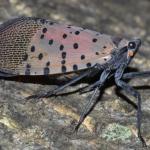 Spotted Lanternfly: (Lycorma delicatula, SLF) is not known to occur in Massachusetts landscapes (no established populations are known in MA at this time). However, due to the great ability of this insect to hitchhike using human-aided movement, it is important that we remain vigilant in Massachusetts and report any suspicious findings. Spotted lanternfly reports can be sent here: https://massnrc.org/pests/slfreport.aspx
Spotted Lanternfly: (Lycorma delicatula, SLF) is not known to occur in Massachusetts landscapes (no established populations are known in MA at this time). However, due to the great ability of this insect to hitchhike using human-aided movement, it is important that we remain vigilant in Massachusetts and report any suspicious findings. Spotted lanternfly reports can be sent here: https://massnrc.org/pests/slfreport.aspx
For a map of known, established populations of SLF as well as detections outside of these areas where individual finds of spotted lanternfly have occurred (but no infestations are present), visit: https://nysipm.cornell.edu/environment/invasive-species-exotic-pests/spotted-lanternfly/ This map depicts an individual find of spotted lanternfly at a private residence in Boston, MA that was reported by the MA Department of Agricultural Resources on February 21, 2019. More information about this detection in Boston, where no established infestation was found, is provided here: https://www.mass.gov/news/state-agricultural-officials-urge-residents-to-check-plants-for-spotted-lanternfly
This insect is a member of the Order Hemiptera (true bugs, cicadas, hoppers, aphids, and others) and the Family Fulgoridae, also known as planthoppers. The spotted lanternfly is a non-native species first detected in the United States in Berks County, Pennsylvania and confirmed on September 22, 2014.
The spotted lanternfly is considered native to China, India, and Vietnam. It has been introduced as a non-native insect to South Korea and Japan, prior to its detection in the United States. In South Korea, it is considered invasive and a pest of grapes and peaches. The spotted lanternfly has been reported from over 70 species of plants, including the following: tree of heaven (Ailanthus altissima) (preferred host), apple (Malus spp.), plum, cherry, peach, apricot (Prunus spp.), grape (Vitis spp.), pine (Pinus spp.), pignut hickory (Carya glabra), sassafras (Sassafras albidum), serviceberry (Amelanchier spp.), slippery elm (Ulmus rubra), tulip poplar (Liriodendron tulipifera), white ash (Fraxinus americana), willow (Salix spp.), American beech (Fagus grandifolia), American linden (Tilia americana), American sycamore (Platanus occidentalis), big-toothed aspen (Populus grandidentata), black birch (Betula lenta), black cherry (Prunus serotina), black gum (Nyssa sylvatica), black walnut (Juglans nigra), dogwood (Cornus spp.), Japanese snowbell (Styrax japonicus), maple (Acer spp.), oak (Quercus spp.), and paper birch (Betula papyrifera).
The adults and immatures of this species damage host plants by feeding on sap from stems, leaves, and the trunks of trees. In the springtime in Pennsylvania (late April - mid-May) nymphs (immatures) are found on smaller plants and vines and new growth of trees and shrubs. Third and fourth instar nymphs migrate to the tree of heaven and are observed feeding on trunks and branches. Trees may be found with sap weeping from the wounds caused by the insect’s feeding. The sugary secretions (excrement) created by this insect may coat the host plant, later leading to the growth of sooty mold. Insects such as wasps, hornets, bees, and ants may also be attracted to the sugary waste created by the lanternflies, or sap weeping from open wounds in the host plant. Host plants have been described as giving off a fermented odor when this insect is present.
Adults are present by the middle of July in Pennsylvania and begin laying eggs by late September and continue laying eggs through late November and even early December in that state. Adults may be found on the trunks of trees such as the tree of heaven or other host plants growing in close proximity to them. Egg masses of this insect are gray in color and look similar in some ways to gypsy moth egg masses.
Host plants, bricks, stone, lawn furniture, recreational vehicles, and other smooth surfaces can be inspected for egg masses. Egg masses laid on outdoor residential items such as those listed above may pose the greatest threat for spreading this insect via human aided movement.
For more information about the spotted lanternfly, visit this fact sheet: https://ag.umass.edu/landscape/fact-sheets/spotted-lanternfly .
- Taxus Mealybug: Dysmicoccus wistariae will produce honeydew and lead to sooty mold growth, yellowing of needles, and sparsely foliated plants. Eventual dieback may be possible. This species is commonly associated with taxus in New England, but can be occasionally found on dogwood, rhododendron, Prunus spp., maple, andromeda, and crabapple. These mealybugs are found on stems and branches and particularly like to congregate at branch crotches. Taxus mealybug feeds in the inner bark tissue of the trunk and branches. Adult females are present from June to August and give birth to living young in the summer. Immatures overwinter. A single generation may occur per year in New England, but areas to the south can have multiple generations of this insect. Management may be targeted between 246-618 GDD’s, base 50°F. Horticultural oil and neem oil may be used.
- Tuliptree Aphid: Illinoia liriodendri is a species of aphid associated with the tuliptree, wherever it is grown. Depending upon local temperatures, these aphids may be present from mid-June through early fall. Large populations can develop by late summer. Some leaves, especially those in the outer canopy, may turn brown or yellow and drop from infested trees prematurely. The most significant impact these aphids can have is typically the resulting honeydew, or sugary excrement, which may be present in excessive amounts and coat leaves and branches, leading to sooty mold growth. This honeydew may also make a mess of anything beneath the tree. Wingless adults are approximately 1/8 inch in length, oval, and can range in color from pale green to yellow. There are several generations per year. This is a native insect. Management is typically not necessary, as this insect does not significantly impact the overall health of its host. Tuliptree aphids also have plenty of natural enemies, such as ladybeetles and parasites.
- Twolined Chestnut Borer: Agrilus bilineatus is a native jewel beetle (also known as a flatheaded borer) in the Family Buprestidae. This insect is also in the same genus as the invasive emerald ash borer. The twolined chestnut borer is native to Massachusetts, much of New England, and the eastern United States. This species has one generation per year and adults are typically active from April – August, depending upon location and temperature. Adults will conduct some maturation feeding on oak prior to mating. Females will lay clusters of tiny eggs in the cracks and crevices of bark. Larvae hatch from the eggs in 1-2 weeks and burrow through the bark into the cambium, where they feed in a similar manner to the emerald ash borer, creating meandering galleries as they feed. (The galleries of the twolined chestnut borer can be straight in very stressed trees.) Larvae typically mature by August – October and burrow to the outer bark where they create a chamber in which they overwinter. Pupation occurs the following spring and adults emerge through D-shaped exit holes that are approximately 1/5 inch wide. In the northern extent of this insect’s range, they can take 2 years to complete their life cycle. Larvae of this insect have been recorded from eastern white oak, common post oak, burr oak, scarlet oak, northern red oak, and eastern black oak. Adults have been recorded on fir and pin oak. These insects are attracted to stressed host plants and typically become a secondary factor in the decline of the tree.
- Two-Spotted Spider Mite: Tetranychus urticae is a “warm-season” mite that loves hot and dry weather, which may favor the quick reproduction and build-up of this pest. Management should seek to preserve beneficial predatory mites. Monitor susceptible hosts (elm, maple, redbud, ash, black locust, tuliptree, and many deciduous shrubs) for increasing numbers of these mites until mid-August. Mites will be found on the undersides of leaves and cause stippling of the foliage.
Concerned that you may have found an invasive insect or suspicious damage caused by one? Need to report a pest sighting? If so, please visit the Massachusetts Introduced Pests Outreach Project: http://massnrc.org/pests/pestreports.htm .
A note about Tick Awareness: deer ticks (Ixodes scapularis), the American dog tick (Dermacentor variabilis), and the lone star tick (Amblyomma americanum) are all found throughout Massachusetts. Each can carry their own complement of diseases. Anyone working in tick habitats (wood-line areas, forested areas, and landscaped areas with ground cover) should check themselves regularly for ticks while practicing preventative measures. Have a tick and need it tested? Visit the web page of the UMass Laboratory of Medical Zoology (https://www.tickreport.com/ ) and click on the blue Order a TickReport button for more information.
Reported by Tawny Simisky, Extension Entomologist, UMass Extension Landscape, Nursery, & Urban Forestry Program
Weeds
Summer annual grass and broadleaf weeds are increasingly more apparent in mulched landscape beds as the recent hot weather has allowed them to get VERY large. Some weeds have become sizable and spraying them will result in unsightly dead vegetation, so hand weeding may be necessary. However, spot spraying with a non-selective herbicide is usually a better strategy than hand-weeding because it does not break the mulch barrier unless the plant is clipped below the stem base, allowing new weed seeds to germinate. Determination on a site-by-site basis will be needed to select the best strategy. Inspect the mulch layer to ensure that it is thick enough to control future weed problems.
Many landscape trees commonly produce vegetative suckers at their trunk base. Suckers are commonly seen on crabapple, flowering cherry, flowering pear, plum, linden, maple and sometimes oak. Honeylocusts commonly produce vegetative sprouts along the entire length of their trunk. If these suckers or sprouts are not controlled, the landscape will be a contender for the “shabby landscape award”. Pruning is effective but very time consuming. Another option would be to use the product ScytheTM that contains pelargonic acid to remove these vegetative suckers and sprouts when they are very small. Very small means less than one inch in length or smaller. Pelargonic acid is a contact herbicide. If ScytheTM is applied to small suckers and sprouts, the product will desiccate them and physical removal will not be required. Larger growth will first need to be physically removed, then ScytheTM can be used as a maintenance program. Products that contain glyphosate should not be used as glyphosate is a translocated herbicide and injury is possible.
New growth expansion of poison ivy continues. Poison ivy is past its flowering period and small green berries can be seen on healthy plants. Herbicide applications can be done from now through mid-September. Glyphosate or triclopyr are the best herbicides for the control of poison ivy. Site will determine which herbicide you select. Glyphosate is a non-selective herbicide, while triclopyr is a broadleaf herbicide, so it will not kill grasses.
Report by Randy Prostak, Weed Specialist, UMass Extension Landscape, Nursery and Urban Forestry Program
Landscape Practices
With two-thirds of Massachusetts in a "Moderate Drought" or "Abnormally Dry" as of 7/21 , according to the US Drought Monitor (https://droughtmonitor.unl.edu/CurrentMap/StateDroughtMonitor.aspx?MA), it is important to irrigate as efficiently as possible. The following tips will help ensure that irrigation applications are as beneficial as possible.
1. Be aware of, and follow, your local town or municipality water regulations.
2. Don’t irrigate midday. Evaporation is greatest midday, which could mean that much of the water being applied is lost before it reaches plants! Wind also contributes to evaporation and can change irrigation spray patterns. Early morning and evening are the best times to irrigate.
3. Use drip irrigation or soaker hoses when possible. Overhead irrigation frequently results in watering non-plant surfaces and can result in water interception by plant canopies which can reduce the water that reaches the plants’ root systems.
4. Maintain your irrigation system. Check for leaks, broken spray heads, and perform an irrigation system audit to assure uniformity.
5. Use smart technology. Smart controllers can monitor soil moisture and use environmental conditions to adjust irrigation based on water being lost to evapotranspiration (evaporation and transpiration).
6. Water deeply, allowing water to soak into the ground. Irrigating slowly (via drip irrigation or a slow flow) is key to achieving infiltration vs. runoff. Newly installed plants will need more frequent irrigation until established, especially container grown plants that were produced in soilless substrates. Less frequent, deeper irrigation encourages good root growth which will help plants survive water stress.
7. Apply mulch to planting beds and in tree rings 2-4” deep. Keep mulch away from the base of plants and trees. Mulch helps reduce evaporation, insulates plant roots, and can add organic matter to the soil.
8. Raise your mower blade. Longer grass promotes deeper roots and a more drought-resistant lawn.
9. Reduce the competition for water by controlling weeds.
10. Don’t apply fertilizer under drought conditions. High fertilizer concentration can make available water unavailable to plants. Fertilization will also result in increased growth which increases the water demand.
11. Keep in mind that landscapes typically require one inch of water per week (including rainfall). Unsure of what your system or sprinkler is applying? You can use a rain gauge and see how much water is collected in a certain period of time (30 minutes for example). Use multiple rain gauges if possible to understand if you have good uniformity, or make sure the rain gauge is located in an “average area”.
Report by Mandy Bayer, Extension Assistant Professor of Sustainable Landscape Horticulture, UMass Stockbridge School of Agriculture
Landscape Turf
Insects
White Grubs
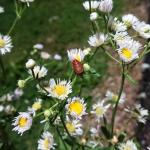
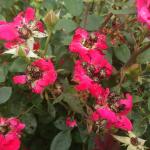 Adults of Oriental and Asiatic garden beetles are at the peak of their flight, and Japanese beetle adult activity is increasing. Adult Oriental and Asiatic garden beetles are flying at night (~8:30 -10:00 PM) and are attracted to light (Oriental beetles also sometimes fly during the day). Japanese beetle adults are active during the day and can be observed on many ornamental plants. Adult flight is a good indication for scheduling neonicotinoid preventive applications, targeting young larvae that will be hatching from eggs. Ideally all applications should be completed by the end of July. It is too late to apply chlorantraniliprole (AceleprynTM) for grubs. The window of opportunity for chlorantraniliprole was earlier, until June 15. Another diamide, cyantraniliprole (FerenceTM) can be applied at the same time as neonicotinoids.
Adults of Oriental and Asiatic garden beetles are at the peak of their flight, and Japanese beetle adult activity is increasing. Adult Oriental and Asiatic garden beetles are flying at night (~8:30 -10:00 PM) and are attracted to light (Oriental beetles also sometimes fly during the day). Japanese beetle adults are active during the day and can be observed on many ornamental plants. Adult flight is a good indication for scheduling neonicotinoid preventive applications, targeting young larvae that will be hatching from eggs. Ideally all applications should be completed by the end of July. It is too late to apply chlorantraniliprole (AceleprynTM) for grubs. The window of opportunity for chlorantraniliprole was earlier, until June 15. Another diamide, cyantraniliprole (FerenceTM) can be applied at the same time as neonicotinoids.
Please note: Neonicotinoids can be toxic to pollinators including honeybees and wild bees. Cyantraniliprole is highly toxic to bees, even though it belongs to the same chemical class (anthranilic diamides) as chlorantaniliprole, which has low bee toxicity. Several measures could be taken to reduce exposure of foraging bees to insecticides: (1) avoiding application on flowering plants, (2) mowing before the application to reduce flowers which attract pollinators, (2) watering in products after application, (3) using granular formulations, (4) avoiding spraying during high winds to minimize drift, (5) and considering spraying in the evening or early in the morning when bees are not foraging. For more information on this topic, see our Neonicotinoid Turf Insecticides and Pollinators fact sheet. https://ag.umass.edu/turf/fact-sheets/neonicotinoid-turf-insecticides-pollinators
It is important to know which white grub species are present and active at your location. For most locations in southern New England, Oriental beetle grubs are the most dominant. However, species composition varies and can be affected by the specific location and the surrounding landscapes. If you noticed many Asiatic garden beetle (AGB) adults flying in your area, neonicotinoid application will most likely not to be effective against this species. Fortunately, AGB is smaller than other grub species and turf can tolerate higher densities (up to 20 per sq. ft.). In addition, AGB frequently occurs in lower maintenance turf, so they rarely cause damage requiring curative application. Monitoring turf quality and grub abundance will determine the need for the curative applications.
Billbugs
It is time to watch for billbug damage. If you notice damage in an area with known or suspected billbug infestation, perform a “tug” test: pull the damaged grass, if it easily breaks off and you see uneven/chewed up ends with sawdust-like larval frass, billbugs are possible culprits. Ideally, soil samples should also be taken and examined for larval activity. Most of the larvae can be found in the thatch zone. Remember that billbug damage often resembles summer dormancy, so lawns that have been struggling in the recent high temperatures and dry conditions may appear to be dormant, but in fact there may be billbug larvae feeding in the area. If that is the case, the turf may not recover when cooler temperatures prevail in September.
Submitted by: Dr. Olga Kostromytska and Dr. Pat Vittum
Additional Resources
To receive immediate notification when the next Landscape Message update is posted, join our email list by emailing your request to eweeks@umext.umass.edu with Subscribe Greeninfo in the subject line, and follow us on Facebook and Twitter.
For a complete listing of upcoming events, see our upcoming educational events https://ag.umass.edu/landscape/upcoming-events
For commercial growers of greenhouse crops and flowers - Check out UMass Extension's Greenhouse Update website
For professional turf managers - Check out Turf Management Updates
For home gardeners and garden retailers - Check out our home lawn and garden resources. UMass Extension also has a Twitter feed that provides timely, daily gardening tips, sunrise and sunset times to home gardeners at twitter.com/UMassGardenClip
Diagnostic Services
A UMass Laboratory Diagnoses Landscape and Turf Problems - The UMass Extension Plant Diagnostic Lab is available to serve commercial landscape contractors, turf managers, arborists, nurseries and other green industry professionals. It provides woody plant and turf disease analysis, woody plant and turf insect identification, turfgrass identification, weed identification, and offers a report of pest management strategies that are research based, economically sound and environmentally appropriate for the situation. Accurate diagnosis for a turf or landscape problem can often eliminate or reduce the need for pesticide use. For sampling procedures, detailed submission instructions and a list of fees, see Plant Diagnostics Laboratory
Soil and Plant Nutrient Testing - The University of Massachusetts Soil and Plant Nutrient Testing Laboratory is located on the campus of The University of Massachusetts at Amherst. Testing services are available to all. The function of the Soil and Plant Nutrient Testing Laboratory is to provide test results and recommendations that lead to the wise and economical use of soils and soil amendments. For complete information, visit the UMass Soil and Plant Nutrient Testing Laboratory web site. Alternatively, call the lab at (413) 545-2311.
Ticks are active any time that temperatures are above freezing! Remember to take appropriate precautions when working and playing outdoors, and conduct daily tick checks. UMass tests ticks for the presence of Lyme disease and other disease pathogens. Learn more
